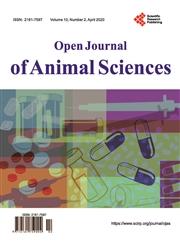Measurement of Metabolic and Inflammatory Serum Markers and Immune Marker Gene Expression during Superovulation in Beef Cattle
引用次数: 0
Abstract
Health status of donor cows during superovulation is important to ensure optimal embryo quality at time of collection. Because nutritional and metabolic status impact embryo quality some form of nutritional supplementation is often provided before and during superovulation. OmniGen-AF® (OG) feeding has been shown to assist in the maintenance of animal health through regulation of metabolic status and balance and supporting aspects of immune function. We observed feeding donor cows OG decreased percent degenerate embryos recovered following superovulation increased serum progesterone concentration and improved in vitro embryo development. Evaluation of OG feeding on markers of metabolic function and inflammatory and immune function in beef cattle embryo donors are reported here. Similarly, cow metabolic and inflammatory response with repeated superovulation protocols is not known. Biomarkers to monitor and evaluate cow health during superovulation may provide management options to improve embryo recovery and quality. Twenty-four Angus cross-bred cattle were randomly assigned to four treatment groups, fed 0 or 56 g/hd/day for 49 days and superovulated with 200 or 400 mg Folltropin V (FSH). Blood was collected weekly for analyses. The protocol was repeated on all cows 90 - 120 d later with cows reassigned to their original groups. No differences (P > 0.10) were observed due to OG feeding or FSH dose on metabolic and inflammatory markers. Replicate exerted a significant effect where serum concentration of albumin, IL1β, IL6, PGE2 and leptin were lower (P < 0.05) in Replicate 1 compared to 2. There was also a similar pattern of change in several of the metabolic and inflammatory markers during the superovulation protocol where concentrations were higher at the time of estrus and ovulation. Taken together, physiologic changes during the estrous cycle and the number of superovulation protocols can modulate metabolic markers and inflammatory response.肉牛超数排卵过程中代谢和炎症血清标志物及免疫标志物基因表达的测定
供体奶牛超排卵期的健康状况对保证胚胎采集时的最佳质量至关重要。由于营养和代谢状况会影响胚胎质量,因此在超排卵前和超排卵期间经常提供某种形式的营养补充。OmniGen-AF®(OG)喂养已被证明可以通过调节代谢状态和平衡以及支持免疫功能来帮助维持动物健康。我们观察到,饲喂OG可降低超排卵后退化胚胎的百分率,提高血清黄体酮浓度,促进体外胚胎发育。本文报道了OG饲喂对肉牛胚胎供体代谢功能、炎症和免疫功能标志物的影响。同样,母牛的代谢和炎症反应与重复的超排卵方案是未知的。在超排卵期间监测和评估奶牛健康的生物标志物可能为改善胚胎恢复和质量提供管理选择。选取24头安格斯杂交牛,随机分为4个处理组,分别饲喂0或56 g/hd/d,连续49 d,过排卵时分别添加200或400 mg促卵泡素V (FSH)。每周采集血液进行分析。90 ~ 120 d后,所有奶牛重复该方案,将奶牛重新分配到原组。OG饲喂或FSH剂量对代谢和炎症指标无显著差异(P > 0.10)。重复影响显著,重复1血清白蛋白、白细胞介素1β、白细胞介素6、PGE2和瘦素浓度低于重复2 (P < 0.05)。在超排卵过程中,几种代谢和炎症标志物也有类似的变化模式,在发情和排卵期浓度较高。综上所述,发情周期中的生理变化和超排卵方案的数量可以调节代谢标志物和炎症反应。
本文章由计算机程序翻译,如有差异,请以英文原文为准。
求助全文
约1分钟内获得全文
求助全文

 求助内容:
求助内容: 应助结果提醒方式:
应助结果提醒方式:


